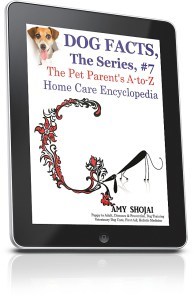Amy Shojai's Blog, page 78
October 14, 2016
How Cats Hunt: Feline Hunting Behavior Explained
How Cats Hunt: Feline Hunting Behavior Explained
Is your kitty a “mighty hunter?” How does your cat hunt and what kind of big game does s/he capture? I’ve written about gift-bearing cats before to explain the whole idea behind why Sheba leaves mousy offerings just for you, URK!
 I’m sharing this information from my HUNTING entry from Cat Facts, The Series 8 (H): The Pet Parent’s A-to-Z Home Care Encyclopedia which includes these topics:
I’m sharing this information from my HUNTING entry from Cat Facts, The Series 8 (H): The Pet Parent’s A-to-Z Home Care Encyclopedia which includes these topics:
Hair, Hairballs, Hair Loss, Heart Disease, Heartworm Disease, Hematoma, Hemotrophic Mycoplasmas, Herbs, High Rise Syndrome, Hip Dysplasia, Holistic Medicine, Homeopathy, Hookworms, Human-Animal Bond, Hunting Behavior, Hyperesthesia Syndrome, Hyperthermia (Heatstroke), Hyperthyroidism, and Hypothermia.
I’ve broken the massive book into discounted catnip-size alpha-chapter sections. Folks can choose which ones they most need. Each chapter will release every other week. Of course, you can still get the entire CAT FACTS book either in Kindle or 540+ pages of print.
Join Amazon Kindle Unlimited 30-Day Free Trial


DO ALL CATS HUNT?
Seren may have the equipment and heritage to hunt, but her finely honed hunting expertise begins with the bowl and ends with (at a stretch) crickets. Oh, but she leaves the buggy drumsticks behind (must not have enough meat on ’em).
Karma-Kat prefers wasps. Ouch! And I have a friend with a cat and Shadow hunts and stalks…(wait for it…) DUST RAGS. Nom-nom-nommy-good.
The ability to hunt requires skill and technique that can only be learned and earned through practice. Kittens hone technical skills through play with their litter mates, and by their mother’s example. If they’re indoor only cats, they may never get the chance to face off against a ferocious sparrow.
The outdoor kitties that do have to feed themselves generally have a low success rate due to poor nutrition or just because the odds are against them. They have much great success with ground-dwelling critters like mice, voles, and lizards since healthy adult birds can stay out of reach.

HOW CATS HUNT
Cats don’t need to be hungry to hunt. It’s the sound and sight of moving prey that provides the stimulus to chase and capture, a hardwired behavior as natural to the cat as purring. That’s one reason kitten play aggression that grapples your moving ankles can prove so energetic and intense.
Feline hunting behavior relies heavily on sight and hearing to locate prey. Cats use a couple of hunting strategies, depending on the prey they seek. Sometimes Kitty prefers ambush, and will crouch in a likely spot — perhaps with eyes glued to the mouse hole — and wait with infinite patience for prey to appear. Cats may return time after time to areas where their hunts have been successful.
CAT FISHING TECHNIQUE
Fishing requires patience, too. Typically the cat waits in a likely spot on the bank for a suitable candidate to appear, then uses a paw to scoop and flip the fish from the water. In shallow water, Kitty may wade in and use both paws by pouncing and grasping the fish.
Not all cats are able to perfect fishing technique, probably because of the visual perception difficulty regarding the water. But even dry-land-dwelling kitties use the fish-scoop technique down a likely hole that may yield something yummy.
STALK AND POUNCE
The stalk-and-pounce method has many components. Once the prey is located, the cat quickly moves closer in a low to the ground pose, and then stops and freezes sometimes for endless moments while watching the prey. If the target moves farther away, the cat adjusts by ever-so-slowly creeping forward one paw-step at a time, even freezing with a foot in mid-air to avoid revealing herself. For the final rush, she gathers rear legs beneath her and treads in preparation for for a forward thrusting take-off. It may require several darting leaps before she’s near enough for the final pounce.
WHY CATS PLAY WITH PREY
Rarely is the quarry dispatched right away. Often, it escapes and Kitty must attempt to chase it down for recapture. Cats often indulge in a great deal of pouncing and tossing of prey into the air, allowing escape only to recapture small game. This isn’t inherent cruelty and serves a couple of purposes. “Playing” with the prey is a way for the cat to practice her skills, and also tests just how dangerous that rat or snake might be. Properly socialized felines have learned to inhibit their bite through play with owners and other cats, and toying with the quarry helps them build up the necessary excitement for the coup-de-grace.
HOW CATS KILL
Cats kill by biting the neck where the skull joins the spine, severing the vertebrae with the dagger-like canine teeth. They grasp the neck and use a “chattering” movement to position their bite accurately. In fact, cats frustrated in the hunt (i.e., watching from a window as squirrels play outside) often exhibit this chattering behavior which is actually the killing bite, in reaction to seeing out-of-reach prey.
 Once the prize is dead and stops moving, the cat typically seems to lose interest for a short time. After the thrill of the hunt, the chase, and the kill, the cat needs time to return to an emotional equilibrium, and she may groom herself before claiming the prize. Then, she’ll carry the prey to a well-sheltered area to eat. Like your pillow.
Once the prize is dead and stops moving, the cat typically seems to lose interest for a short time. After the thrill of the hunt, the chase, and the kill, the cat needs time to return to an emotional equilibrium, and she may groom herself before claiming the prize. Then, she’ll carry the prey to a well-sheltered area to eat. Like your pillow.
Find out more details about catnip and other “H” topics in Cat Facts, The Series 8 (H): The Pet Parent’s A-to-Z Home Care Encyclopedia.
I love hearing from you, so please share comments and questions. Note: Upon occasion, affiliate links to books or other products may be included in posts, from which I earn a small amount with each purchase from the blog. Do you have an ASK AMY question you’d like answered? Stay up to date on all the latest just subscribe the blog, “like” me on Facebook, and sign up for Pet Peeves newsletter. Stay up to date with the latest book give aways and appearances related to my September Day pet-centric THRILLERS WITH BITE!
AMY SHOJAI'S Bling, Bitches & Blood - Practical Solutions for Pets Problems & Publishing
October 7, 2016
Dog Hot Spots & Home Remedies
Dog hot spots are the bane of our canine friends, often happening during both the spring and fall shedding season. When dog hot spots are a chronic problem, it can be aggravating and frustrating for pet owners. And painful for the dog! While severe problems need veterinary attention, home remedies for dog hot spots often help enormously.

Thickly furred dogs like the Chow are more prone to hot spots during shedding season.
I’m sharing this entry about dog HOT SPOTS which is an excerpt from Dog Facts, The Series 8 (Chapter H). This chapter covers a lot of ground, and here’s the topic list:
Hair, Hair Loss, Heart Disease, Heartworm Disease, Hematoma, Hemophilia, Herbs, Hernia, Hip Dysplasia, Holistic Medicine, Homeopathy, Hookworms, Hot Spots, House Training, Human-Animal Bond, Hunting Behavior, Hyperparathyroidism, Hyperthermia (Heatstroke), Hyperthyroidism, Hypoglycemia (Low Blood Sugar), Hypoparathyroidism, Hypothermia, and Hypothyroidism.
I’ve broken the massive book into discounted treat-size alpha-chapter sections. Folks can choose which ones they most need. Each chapter will release every other week. Of course, you can still get the entire book either in Kindle or 630+ pages of print.
WHAT ARE DOG HOT SPOTS?
Also referred to as acute moist dermatitis, a hot spot is a localized area of self-induced trauma that becomes infected. Dogs suffering from atopy (inhalent allergy) are at highest risk. But all dogs can develop these sores.
Dog breeds with heavy double coats like Chow Chows and German Shepherds like Magic seem most prone to developing hot spots immediately prior to shedding, when dead hair may be trapped next to the skin. For unknown reasons, Golden Retrievers tend to develop deeply infected hot spots.
These days, Magic is shedding like crazy, leaving drifts of black woolly fur everywhere. If I didn’t constantly comb and pull off the dead clumps, chances are he’d develop dog hot spots, too.

Magic has never had a hot spot–but he sheds like crazy!
DIAGNOSING DOG HOT SPOTS
Hot spots can appear anywhere on the dog’s body, but the rump, tail, back, and flanks are common sites. Usually, the hot spot appears suddenly as an initially small circular area of hair loss, but they can spread rapidly. Sores can grow to several inches in diameter within a few hours. The infection often smells bad and secretes pus, and hot spots typically are moist due to licking and/or the weeping of the wound, and hot because of infection and inflammation.
No one is certain what causes a hot spot to form, but it’s thought to be prompted by some minor irritation, like a flea bite. Itchiness and discomfort prompts licking and nibbling, and when the dog can’t leave the wound alone, a hot spot erupts.
HOW TO TREAT DOG HOT SPOTS WITH HOME REMEDIES
Treatment consists of getting air to the infection so it will heal and dry, and preventing further self-mutilation. A collar restraint prevents him from licking or nibbling the sore.
Hot spots are both itchy and painful, and often require a veterinarian to sedate the dog before treatment can begin. The fur surrounding the area is clipped away, the skin is cleansed with an antibacterial preparation like diluted hydrogen peroxide, Nolvasan, Betadine, Oxydex or pHisoHex. Pet-formulations of benzoyl peroxide-containing cleansers help reduce the itchiness, dry the lesion, and flush out hair follicles, as well as kill certain bacteria.
Once cleansed, a medication like Burrow’s solution, available at most drug stores or pet stores, may be applied and seems to work quite well to dry the sore. Holistic veterinarians recommend using calendula to soothe the sore. Witch hazel can help cool down the heat of hot spots because it evaporates as quickly as alcohol but without the sting. You can use that two or three times a day.
Another natural remedy for hot spots is the tannic acid found in black tea. This astringent helps dry out the sores so they heal more quickly. Soak a tea bag in hot water, let it cool, and apply the bag directly to the sore for five minutes. You can do this three or four times a day.
VETERINARY TREATMENTS FOR DOG HOT SPOTS
The veterinarian may prescribe ointments like Panalog or Neocort, or short-acting corticosteroids like prednisone that reduce the irritation. Occasionally, antibiotics are required to clear up deep infection. The underlying problem, fleas, allergy, or whatever, must also be addressed.
Since dogs aren’t able to adequately groom themselves, owners must take great responsibi lity for seeing that coat care is provided. Grooming during shedding season is particularly important, and can help prevent problems like hot spots from developing.
lity for seeing that coat care is provided. Grooming during shedding season is particularly important, and can help prevent problems like hot spots from developing.
Find out more details about other “H” topics in Dog Facts, The Series 8 (Chapter H).
How about your dogs? Do they suffer from hot spots? How do you manage the sores?
I love hearing from you, so please share comments and questions. Note: Upon occasion, affiliate links to books or other products may be included in posts, from which I earn a small amount with each purchase from the blog. Do you have an ASK AMY question you’d like answered? Stay up to date on all the latest just subscribe the blog, “like” me on Facebook, and sign up for Pet Peeves newsletter. Stay up to date with the latest book give aways and appearances related to my September Day pet-centric THRILLERS WITH BITE!
AMY SHOJAI'S Bling, Bitches & Blood - Practical Solutions for Pets Problems & Publishing
October 4, 2016
Pet-centric Books? Proud to Be #PoweredByIndie
Pet-centric Books? Proud to Be #PoweredByIndie
During the month of October, Amazon is celebrating great writing self-published via Kindle Direct Publishing (KDP), CreateSpace and Audiobook Creation Exchange (ACX). The celebration will include a dedicated Amazon landing page and special features on the KDP social media page celebrating books #PoweredByIndie.
I published dozens of books the “traditional” way with New York via the help of a fantastic, high-power agent. Today, the majority of my work is self-published using tools provided by Amazon and others.
Currently, I have 65 KDP titles either already published or ready to release. Ten of these titles are available via CreateSpace, including three scripts and two piano-vocal scores. Also, I’ve published five audio books released via ACX with 7 more in production.
New Choices in Natural Healing for Dogs & Cats
Here’s an example. New Choices released in hardcover in Fall 1999, sold extremely well, and was later released in a soft cover edition in 2001. But it went out of print about 10 years ago, yet “used” copies remained in demand. So . . .
As an Indie author, the answer to me was simple. Release a new edition but this time make it even more available. The new, larger-format 2016 edition released last week, with the Kindle version still percolating (stay tuned!), and I’ll be “voicing” the book for the audio version through ACX, as well.
I Love Being Indie Because . . .
I love being indie (or maybe more accurately, a “hybrid”) author. That gives me freedom to create and distribute work quickly and with flexibility to my pet-centric audience. I get to choose–or ask my readers for input–about covers, titles, and content. It’s a new partnership, no longer ruled by an unknown committee. I partner with my choice of editors, designers, and others to best serve readers who depend on me for accurate and entertaining content.
Timing Is Everything
As a nonfiction author of prescriptive pet books, I was frustrated by how long it took to get the latest information to readers. 18 MONTHS OR MORE, are you KIDDING ME? Updates were impossible, when new information was discovered or old info discredited.
Today, that’s changed. I can release books when I want. I’m able to distribute my books how I want. I can decide what platforms to use. With my Cat Facts and Dog Facts book, I’m even releasing them one chapter at a time.

With pets (and hence, pet books), something new always pokes its cold, inquisitive nose over the horizon–or into your armpit, LOL! Self-publishing allows me to include the latest greatest nonfiction breakthroughs, and bring back out-of-print favorite titles for a brand new audience to discover. Oh, and it allows me to experiment with work that causes traditional publishers to turn tail and run.
Amazon Self-Publishing for Fur-ocious Fiction-ing
As a hybrid author #PoweredByIndie I finally got to write the stories I’d always wanted to read. I’m now able to create innovative works of fiction my readers love. I’ve even garnered fantastic endorsements from best-selling authors.
All this, for stories “New York” publishers would probably never have offered a chance. And as a self-published author working with ACX, I get to choose who “voices” my stories, hold auditions for VO artists, or even produce audio books myself in my home studio. Can you say, “author-preneur?”
Yes, my THRILLERS WITH BITE include a service dog viewpoint character. My Lei Crime Kindle Worlds novella BORN TO LOVE features the viewpoint of a puppy-police-dog-in-training. Did you even KNOW about the opportunities offered by Kindle Worlds for writer? Mee-wow & arooooo, who’d-a-thunk-it?
What about you? Are you an “indie” author or a reader that appreciates this brave new world? Don’t forget to check out all the great titles this month on the Amazon landing page (let me know if you find one or more of my books there, too!).
I love hearing from you, so please share comments and questions. Do you have an ASK AMY question you’d like answered? Do you have a new kitten and need answers?Stay up to date on all the latest just subscribe the blog, “like” me on Facebook, and sign up for Pet Peeves newsletter. Stay up to date with the latest book give aways and appearances related to my September Day pet-centric THRILLERS WITH BITE!
AMY SHOJAI'S Bling, Bitches & Blood - Practical Solutions for Pets Problems & Publishing
September 30, 2016
Cat Grooming Tips: How To Bathe Cats
Cat Grooming Tips: How To Bathe Cats
Bathe cats, are you INSANE?! Well…not really. Besides, I found that picture and just had to share. But just because the cat says, “No way!” doesn’t mean it’s not possible.
Karma-Kat is a weenie when it comes to getting wet. He’s gotten into the bad habit of standing on top of his “puddles” while digging to cover them in the litter box. As a result, one rear paw gets nasty-wet with litter stuck halfway up his leg, and just dunking that foot sends Karma into near-hysterics.
I’m sharing this information from my GROOMING entry from Cat Facts, The Series 7 (G): The Pet Parent’s A-to-Z Home Care Encyclopedia which includes these topics:
Geriatric Cat, Giardia, Gingivitis, Glaucoma, Grass (Eating), Grief, and Grooming.
I’ve broken the massive book into discounted catnip-size alpha-chapter sections. Folks can choose which ones they most need. Each chapter will release every other week. Of course, you can still get the entire CAT FACTS book either in Kindle or 540+ pages of print.
Join Amazon Kindle Unlimited 30-Day Free Trial

When & Why to Bathe Cats
Why risk life and limb bathing your cat? Does it really matter that she’s gray instead of snowy white? Well, if the kitty gets into something, you may need to suds her up. A bath stimulates the skin and removes excess oil, dander, and shed hair. But bathing too often can dry the skin. As a good rule of “paw” bathe shorthaired cats no oftener than every six weeks; two to three times a year during shedding season should suffice unless Kitty gets really grubby, or is a show cat. Longhaired cats benefit from more frequent baths, and felines appearing in shows learn as kittens to accept baths.
Karma is a fastidious boy and usually keeps himself spiffy, but this new bad habit means he tracks “stuff” around. And, I’m not a fan of him having to lick off/ingest the soiled litter, either.
Kittens should not be bathed until they are at least four weeks old–learn more about kitten care in my book. Elderly cats or extremely ill cats may be stressed by bathing so follow your veterinarian’s recommendation in these instances. These days Seren plays the “age” card to keep her fur dry.
How To Bathe Cats–Plan Ahead
Should you decide to take the plunge–pun intended–your cat should be thoroughly brushed and/or combed ahead of time. All mats must be removed before bathing, because water will just cement mats in place.
The bath area should be warm and draft free. The bathtub will do, but your knees will thank you for using a waist-high sink. Move all breakables out of reach, and push drapes or shower curtains out of the way or they may spook your cat and end up shredded.
For routine cleaning, you only need a simple grooming shampoo labeled specifically for cats. Human baby shampoo or dog products can be too harsh and dry the skin or in some cases prove toxic.
Assemble your shampoo, several towels, and washcloth near the sink or tub, and run warm water (about 102 degrees, or cat body temperature) before you bring in the cat.
Wear old clothes. Expect to get wet. Seren clutches my shirt, pressing her face to me as I wet and soap the rest of her.
Also, close the door to the bathing area, or you risk having a soapy cat escape and leave suds and a wet cat print trail throughout your spanking-clean house.
Cats hate the insecure footing of the slippery surfaces so place a towel or rubber mat in the bottom of your tub or sink. That does wonders for cat confidence and often reduces yowls and struggles by half.
How to Bathe Cats With The Bucket Method
For small kitties the bucket method of bathing often works best. Use the double sink in the kitchen, two or more large roasting pans, or a couple of buckets or wastebaskets set in the bathtub. Fill each with warm water.
Gently lower your cat into the first container to get her wet. Let your kitty stand on her hind legs and clutch the edge of the container as you thoroughly wet the fur.
Then lift her out onto one of your towels, and apply the shampoo to her body.
After lathering, dip the cat back into the first container to rinse. Get as much soap off as possible before removing and sluice off excess water before rinsing in subsequent containers of clean water or use a low-level spray closed to the body with the sink attachment.
If the cat acts scared of being dunked or the spray attachment, use a cup or ladle to dip water. Use the washcloth to wet, soap and rinse the face area. Keep one hand on the cat at all times to prevent escapes.
Rinse beginning at the neck and down Sheba’s back; don’t neglect beneath the tail or tummy. When the water finally runs clear and you know she’s clean, rinse once more just to be sure.
Wrap the squeaky-clean cat in a dry towel. Shorthaired cats dry quickly, but longhaired felines may need two or more towels to blot away most of the water. Seren prefers to dry her
self. If your cat tolerates or enjoys the blow dryer, use only the lowest setting to avoid burning the cat. Combing long fur as you blow dry will give “oomph” to the longhaired coat.
KARMA SOLUTION
For Karma, I’ve found it works best to use the nozzle sprayer. He hates being “dunked” and the water coming from the faucet intimidates him. Go figure…he’s a sink cat and loves sitting in the e mpty basin, but that’s HIS choice, LOL!
mpty basin, but that’s HIS choice, LOL!
Find out more details about catnip and other “G” topics in Cat Facts, The Series 7 (G): The Pet Parent’s A-to-Z Home Care Encyclopedia.
Have you ever bathed your cat? What would cause you to dare the impossible? I used to bathe Seren at least once a year just to prove to us both it could be done. She’s now only
5 pounds so I figure that I’m the biggest “cat” in the house…but I think this year she may win the contest.
I love hearing from you, so please share comments and questions. Do you have an ASK AMY question you’d like answered? Do you have a new kitten and need answers? Stay up to date on all the latest just subscribe the blog, “like” me on Facebook, and sign up for Pet Peeves newsletter. Stay up to date with the latest book give aways and appearances related to my September Day pet-centric THRILLERS WITH BITE!
AMY SHOJAI'S Bling, Bitches & Blood - Practical Solutions for Pets Problems & Publishing
September 23, 2016
Why Dogs Eat Grass
Magical-Dawg often enjoys eating grass–did you ever wonder why dogs eat grass? With Magic, he tends to munch on the freshest shoots, particularly when he’s not yet eaten his breakfast. Of course, then he has to vomit (yuck!), so we try to avoid allowing the behavior when we can.
GET DOGGY VOMITING TREATMENT TIPS NOW!
 I’m sharing this entry about why dogs eat grass which is an excerpt from Dog Facts, The Series 7 (Chapter G). This chapter covers a lot of ground, and here’s the topic list:
I’m sharing this entry about why dogs eat grass which is an excerpt from Dog Facts, The Series 7 (Chapter G). This chapter covers a lot of ground, and here’s the topic list:
Geriatric Dog, Giardiasis, Glaucoma, Grape/Raisin Toxicity, Grass (Eating), Grief, and Grooming.
I’ve broken the massive book into discounted treat-size alpha-chapter sections. Folks can choose which ones they most need. Each chapter will release every other week. Of course, you can still get the entire book either in Kindle or 630 pages of print.
WHY DOGS EAT GRASS
Dogs are omnivores, which means they can eat nearly anything, including vegetables or fruits. Wild canids like coyotes typically eat vegetable matter found in the stomach and intestines of prey animals, but may also eat roots, grasses and even fruit. Our dogs often beg for and enjoy snacks of raw vegetables like lettuce, green beans and carrots.
While some dogs eat weird stuff and get into trouble, it’s not unusual for dogs to eat grass.
Most pet dogs occasionally eat grass, which may be used as a natural emetic to stimulate vomiting when the dog feels unwell. However, grass eating does not always result in vomiting; some dogs may simply relish the flavor or texture. Some speculation exists that grass grazing may provide trace elements of vitamins.
Indoor dogs may indulge their urge to graze by nibbling houseplants which, depending on the  plant, may be dangerous. Occasional grass eating isn’t a cause for concern. However, if grazing becomes a habit, and especially if grass eating prompts vomiting more than two days in a row, your dog should be examined by a veterinarian to rule out a health problem.
plant, may be dangerous. Occasional grass eating isn’t a cause for concern. However, if grazing becomes a habit, and especially if grass eating prompts vomiting more than two days in a row, your dog should be examined by a veterinarian to rule out a health problem.
GET DOGGY VOMITING TREATMENT TIPS NOW!
Find out more details about other “G” topics in Dog Facts, The Series 7 (Chapter G).
How about your dogs? Do they eat grass? Does it make ’em “whoops” or do they just enjoy grazing?
I love hearing from you, so please share comments and questions. Do you have an ASK AMY question you’d like answered? Do you have a new kitten and need answers? Stay up to date on all the latest just subscribe the blog, “like” me on Facebook, and sign up for Pet Peeves newsletter. Stay up to date with the latest book give aways and appearances related to my September Day pet-centric THRILLERS WITH BITE!
AMY SHOJAI'S Bling, Bitches & Blood - Practical Solutions for Pets Problems & Publishing
September 16, 2016
Flower Essences for Cats & Dogs: What Are They & How to Use Them
Flower Essences for Cats & Dogs: What Are They & How to Use Them
Have you ever used flower essences for dogs and cats? Do you think they’re effective? Or is this “woo-woo” stuff just a hoax that works, if at all, with a placebo effect?

I’m sharing this information from my FLOWER ESSENCE entry from Cat Facts, The Series 6 (F): The Pet Parent’s A-to-Z Home Care Encyclopedia which includes these topics:
False Pregnancy, Fear, Feline Hepatic Lipidosis (FHL), Feline Immunodeficiency Virus (FIV), Feline Infectious Peritonitis (FIP), Feline Ischemic Encephalopathy, Feline Leukemia Virus (FeLV), Feline Panleukopenia Virus (FPV), Feral, Flatulence, Fleas, Flower Essences, Food, Food Additives, Food Supplements, Fracture, and Frostbite
I’ve broken the massive book into discounted catnip-size alpha-chapter sections. Folks can choose which ones they most need. Each chapter will release every other week. Of course, you can still get the entire CAT FACTS book either in Kindle or 540+ pages of print.
Join Amazon Kindle Unlimited 30-Day Free Trial

WHAT ARE FLOWER ESSENCES FOR DOGS AND CATS
Flower essences are a type of “vibrational therapy” made from the essential oils of wild plants, trees, and bushes said to offer benefits to the emotional state of pets. Several brands are available. One of the best known, Bach Flower Remedies, consists of 38 individual essences made by infusing spring water with wild flowers either by steeping in the sun or by boiling.
TREATING DOG AND CAT EMOTIONS?
You’d think such things must come from a “new age” mentality, but Bach Flower Remedies were created by British physician Dr. Edward Bach in the early 1900s. He believed disease to be a physical sign and end product of unhappiness, fear and worry, and identified twelve “pathological emotional states” in people that the essences are designed to treat:
fear
terror
mental torture or worry
indecision
indifference or boredom
doubt or discouragement
over-concern
weakness
self-distrust
impatience
over-enthusiasm
pride or aloofness
We can’t know with certainty that pets feel the same emotions as people do, but holistic veterinarians have used the remedies with success, by attempting to identify the emotional state in dogs and cats.

BUT ARE THEY SAFE?
The great thing about Bach Flowers is they can be used safely by anyone. Even if you use the wrong remedy, although it may not help it won’t cause problems. The essences are easy to use. They don’t work in all cases, but when they do, they tend to work very quickly. You can combine them, but will get the best results by limiting to no more than three at a time.
Each individual flower essence treats a specific type of anxiety. They won’t cure behavior or health problems by themselves, but can help when used alongside other techniques. Occasionally more than one flower essences is combined into one remedy. The premixed Rescue Remedy, for example, contains the essences of Impatiens, Star of Bethlehem, Cherry Plum, Rock Rose, and Clematis. Rescue Remedy is considered an “emergency remedy” good for any kind of sudden stress or shock.

HOW TO USE FLOWER ESSENCES FOR DOGS AND CATS
While you can take the remedies undiluted, it’s best to prepare a treatment bottle from the full-strength glass “stock bottle” you purchase.
Obtain a glass 30 ml (1 oz.) dropper bottle and fill with spring water (not tap water).
Add two drops of your chosen Remedy to the new bottle of spring water. It’s best to limit this to three Remedies in the same bottle.
Shake well, at least ten times (practitioners call this “succussing”).
Store the stock bottle and treatment bottle in a dark, cool place. The stock bottle should last for a very long time in this way.
TREATING CATS AND DOGS WITH FLOWER ESSENCES
To treat your cat or dog, use the treatment bottle and shake it each time before putting three drops in the water bowl for Kitty and Fluffy to sip all day. It won’t hurt if the other pets also drink. Alternatively, you can mix the drops into a teaspoonful of plain yogurt for the cat or dog to take as a treat.
Since it’s a vibrational energy medicine, practitioners say that simply dripping the two drops on the pet’s forehead or a paw also works. Don’t let the dropper touch the skin, fur or mouth or you’ll contaminate the bottle. Holistic veterinarians usually advise giving three drops, one to four times a day as needed, until your pet acts like she feels better. More is NOT better—Bach Flower Remedies work best over a longer period of time.
 Find out more details about catnip and other “F” topics in Cat Facts, The Series 6 (F): The Pet Parent’s A-to-Z Home Care Encyclopedia.
Find out more details about catnip and other “F” topics in Cat Facts, The Series 6 (F): The Pet Parent’s A-to-Z Home Care Encyclopedia.
So…is vibrational energy a bunch of hooey? And just for the sake of argument…if it IS a kind of placebo effect (can pets have a placebo effect???) what’s wrong with that if your cat and dog feels better?
I love hearing from you, so please share comments and questions. Do you have an ASK AMY question you’d like answered? Do you have a new kitten and need answers? Stay up to date on all the latest just subscribe the blog, “like” me on Facebook, and sign up for Pet Peeves newsletter. Note: I am an affiliate of Amazon and some links earn me a small referral fee. Stay up to date with the latest book give aways and appearances related to my September Day pet-centric THRILLERS WITH BITE!
AMY SHOJAI'S Bling, Bitches & Blood - Practical Solutions for Pets Problems & Publishing
September 12, 2016
Second Story Kitty? Tips for Grounding Countertop Cruising Cats
Second Story Kitty? Tips for Grounding Countertop Cruising Cats
Do you struggle with how to keep cats off counters? Cats become pests with their determination to stay above it all. They cruise kitchen countertops, lounge atop doors and leap to refrigerator tops to ambush treats.
Today I’m traveling to New York to give a talk at the BlogPurr event about the different kinds of “cat parents” from drama-mamma to doting dad. Do your cats get away with everything, or are you a strict “parent?” It seemed appropriate to focus today’s blog on a common kitty challenge.
The urge to be the top cat seems a universal kitty vice. By understanding why cats scale the heights, cat care givers can provide legal outlets that keep both the kitty happy, and out of your butter dish.

Why Cats Love Heights
Cats come pre-programmed to seek elevated lounging spots. Think about it–a kitty walking on the wild side wants to see enemies (and potential munch-able critters) but remain invisible. A cat quite literally believes she “owns” the space she can see.
Cats also control each other’s interactions—or even the dog’s movements—with pointed stares. This cats-eye-power packs even more punch from an elevated perch, giving the cat ownership and control over even more territory. The cat that commands the highest perch is the high-cat-on-the-totem pole in that particular room.
What’s The Attraction?
Individual cats may have specific preferences for lounge spots. But in general, there are five reasons cats seek a particular place.
The taller the perch, the more important the cat.
Perches near important pathways like windows or stairways offer high kitty value.
Cats are furry heat-seeking missiles, so the tops of warm TVs or computer monitors, or snuggled under lamps prove irresistible. My cat loves to sleep in the paper well of my printer.
Lounging requires a soft, comfy surface like the back of chairs.
Kitchen counters and stove tops smell yummy or even have snacks within paw reach that keep the cat burglar returning to the scene of the cat crime.
You won’t keep your cat on the ground. Cats tend to avoid low spots with no view, or that are cold and uncomfortable. So give your cat what she wants with irresistible legal perch options and make forbidden spots unattractive.

Cats naturally love heights.
How to Keep Cats Off Counters & Grounding High Rise Cats
Evaluate your cat’s favorite perches, and make your choice better. My cat Seren loves to lounge on top of the piano (height) beneath a lamp (warmth) next to the window (view). To purr-suade her otherwise, we placed a three-tiered cat tree that’s TALLER than the piano and has a softer surface (comfort), still under the lamp beside the piano, and still in front of the window.
For your cat household, have at least one cat tree (or acceptable high-value lounge spot) for each cat. Otherwise, they may argue over who gets first dibs.
Make the legal lounge taller than the forbidden object, but nearby so the location remains attractive. An empty bookshelf can work, or even an inexpensive ladder. Put a cat bed stocked with kitty treats on the paint rack.
Make off-limits spots unattractive. Booby-trap counters so they’re no longer comfy. Double-sided tape products like Sticky Paws applied to place mats can be scattered on forbidden surfaces, for example.
Cats hate weird textures, too. Aluminum foil that covers stove tops can keep some cats at bay.
For hard case cats, invest in clear plastic carpet runner to line the counter top, dining table or other illegal location. Just place it nub-side up, and kitty will seek a more comfy spot to lounge.
You can also set up the SSScat[image error] Product, an aerosol can with a motion detector that hisses air to shoo critters away even when you’re not there.
 Choose which battles to fight, because it’s hard to win them all—and you want your cat to like you. My cats are not allowed on the mantel where they play gravity experiments with fine breakables. But they won the battle of the dining room table where Karma and Seren lounge in plush cat beds beneath a stained glass lamp.
Choose which battles to fight, because it’s hard to win them all—and you want your cat to like you. My cats are not allowed on the mantel where they play gravity experiments with fine breakables. But they won the battle of the dining room table where Karma and Seren lounge in plush cat beds beneath a stained glass lamp.
I’ve also trained Seren to exit the printer when I need it. Karma hasn’t quite gotten that messag e yet, though. In families, sometimes you must compromise.
e yet, though. In families, sometimes you must compromise.
What about you? How do you manage your counter top cruising kitties? Do tell!
Learn about more cat behavior issues in ComPETability.
I love hearing from you, so please share comments and questions. Do you have an ASK AMY question you’d like answered? Do you have a new kitten and need answers? Stay up to date on all the latest just subscribe the blog, “like” me on Facebook, and sign up for Pet Peeves newsletter. Note: I am an affiliated of Amazon and some links earn me a small referral fee. Please stay up to date with the latest book give aways and appearances related to my September Day pet-centric THRILLERS WITH BITE!
AMY SHOJAI'S Bling, Bitches & Blood - Practical Solutions for Pets Problems & Publishing
September 9, 2016
Doggy Stink Bomb? Dealing with Canine Flatulence
Doggy Stink Bomb? Dealing with Canine Flatulence

WHAT IS CANINE FLATULENCE?
Also referred to as passing gas, this stinky dog condition is both offensive and embarrassing to a dog owner. Gas is produced naturally in the intestines during digestion, and some dogs produce more than others. Usually, the obnoxious condition isn’t dangerous, but flatulence can be the sign of a health problem.
I’m sharing this entry about canine FLATULENCE, an excerpt from Dog Facts, The Series 6 (Chapter F) This chapter covers a lot of ground, and here’s the topic list:
Fading Puppy Syndrome, False Pregnancy, Fear, Fence, Feral, Flatulence, Fleas, Flower Essences, Flukes, Food, Food Additives, Food Supplements, Fracture, Frostbite, and Fungus.
I’ve broken the massive book into discounted treat-size alpha-chapter sections. Folks can choose which ones they most need. Each chapter will release every other week. Of course, you can still get the entire book either in Kindle or 630+ pages of print.
Join Amazon Kindle Unlimited 30-Day Free Trial

 WHAT CAUSES CANINE FLATULENCE?
WHAT CAUSES CANINE FLATULENCE?What and how the dog eats influences how much gas will be produced, and ultimately passed. Inappropriate food supplements, snacking from the garbage, or any sudden change in diet can make the problem worse. Diets that include highly fermentable substances, large quantities of milk, or simply gulping air when eating or drinking are common causes.
Gorging allows food to stay in the stomach for extended periods, and tends to make dogs more prone to gas. Feed your dogs separately to cut down on competition. Slow the gulper by placing a large non-swallowable ball in the bowl so she must eat around it. Invest in a foraging feeder, bowls designed to make dogs work to reach the food.
REDUCING DOGGY STINK BOMBS
Try offering the dog a more digestible diet. Check the ingredient list on the package and ask your veterinarian to recommend an appropriate choice. Change diets gradually over a week’s period, by initially mixing two-thirds of the old diet with one-third new. Progress to half and half, then one-third to two-thirds, and finally the new diet entirely.
The flower essence crab apple can help bring the body back into balance. Add two or three drops onto your pet’s tongue or in his drinking water each day. Adding digestive enzymes to your dog’s food may also help. As your holistic veterinarian for a recommendation.
Another helpful option is garnishing the dog’s regular diet with a tablespoonful of plain yogurt, which contains beneficial bacteria that helps digestion and reduces flatulence. Many dogs love the flavor. As a last resort, your veterinarian may prescribe a human medication that contains simethicone and activated charcoal to control the gas. There is also an anti-gas veterinary product called CurTail that contains an enzyme that aids food digestion and reduces flatulence. Amazon also has a number of potential remedies for dog flatulence[image error].
 Find out more details about other “F” topics in Dog Facts, The Series 6 (Chapter F).
Find out more details about other “F” topics in Dog Facts, The Series 6 (Chapter F).
Do you suffer from doggy stink bombs? How do you manage gassy pets? Any successful tips you can share? Fire away! (pun intended…)
I love hearing from you, so please share comments and questions. Do you have an ASK AMY question you’d like answered? Do you have a new kitten and need answers? Stay up to date on all the latest just subscribe the blog, “like” me on Facebook, and sign up for Pet Peeves newsletter. Note: I am an affiliated of Amazon and some links earn me a small referral fee. Please stay up to date with the latest book give aways and appearances related to my September Day pet-centric THRILLERS WITH BITE!
AMY SHOJAI'S Bling, Bitches & Blood - Practical Solutions for Pets Problems & Publishing
September 2, 2016
Are Ear Mites Bugging Your Cat?
Are Ear Mites Bugging Your Cat?
EAR MITES LOVE CATS (DOGS, TOO)
These tiny parasites are common in cats, and causes otodectic mange, more commonly known as ear mite infestation. Ear mites (Otodectes cynotis) are a kind of arthropod that are actually related to and look something like spiders. The first four legs of all stages bear unjointed short stalks and suckers, and adult males also have suckers on the rear legs. Ewwww!

Ear mites are so tiny, the “evidence” may not be seen except under a microscope.
I’m sharing this information from my EAR MITES entry from Cat Facts, The Series 5 (E): The Pet Parent’s A-to-Z Home Care Encyclopedia which includes these topics:
Ear Mites, Ears, Eating, Eclampsia (Milk Fever), Electrical Shock, Elizabethan Collar, Endoscope, Enteritis, Eosinophilic Granuloma Complex, Epilepsy, Euthanasia, and Eyes
I’ve broken the massive book into discounted catnip-size alpha-chapter sections. Folks can choose which ones they most need. Each chapter will release every other week. Of course, you can still get the entire CAT FACTS book either in Kindle or 540+ pages of print.
Join Amazon Kindle Unlimited 30-Day Free Trial [image error]
EAR MITE LIFE CYCLE
The mites live on the surface of the skin of the ear and ear canal. Adult females lay eggs with cement that sticks them in place. After incubating four days, eggs hatch into six-legged larvae. Larvae feed for three to ten days, consuming the debris of the ear canal, and piercing the skin to suck lymph. Each larva hatches into an eight-legged protonymph, which then molts into a deutonymph. The deutonymph becomes attached to an adult male end to end by the suckers on their rear legs. If a female adult emerges from the deutonymph, fertilization occurs and the female becomes egg bearing. The life cycle lasts three weeks.

Intense itching with resultant scratching can damage the ear.
CONSEQUENCES OF EAR MITES
Ear mites are the most common cause of ear inflammation. Symptoms of ear mite infestation include brown, waxy debris in the ear canal, and/or crust formation. The crawling mites inside the ear canal produce intense itching and discomfort. Infested cats will shake their heads, dig at their ears, and show a variety of restless behavior.
Excessive head shaking or scratching at the ears caused by ear mites can result in secondary trauma to the pinna, the external portion of your cat’s ear. This can cause a kind of blood blister called a hematoma.
DIAGNOSING EAR MITES
Ear mites are extremely contagious, and outdoor cats are most commonly affected. These parasites aren’t selective; they infest many species, including cats, dogs, rabbits, ferrets and other pets. Kittens often acquire ear mites from their mother.
If one pet is diagnosed with ear mites, all the animals in a multi-pet household must be treated to prevent reinfestation. When left untreated, ear mites can cause severe problems of the middle and inner ear, which may affect the cat’s hearing and balance.
Diagnosis is made by actually seeing the mite. The parasite is tiny, white, and nearly impossible to see with the naked eye. Generally, the veterinarian will make a slide of a sample of the ear debris, and examine it under the microscope to identify the parasite.
HOW TO TREAT CAT EAR MITES
Treatment consists of flushing out the debris, and applying insecticide to kill the mites. Bland oil, like mineral oil squirted into the ear canal followed by gentle massage helps flush out the crumbly material. Because of the three week lifespan of the mites, more than one treatment may be necessary to kill the mites as they hatch.
A number of over the counter ear drop medications are available for treating ear mites in cats. Many of them contain insecticides such as carbaryl or pyrethrins in a mineral oil solution. Sometimes, steroids are necessary to help the inflammation subside, and antibiotic ointment may be indicated to treat bacterial infections.
NATURAL OPTIONS FOR TREATING EAR MITES
Holistic veterinarians may recommend using a green tea rinse, since it’s a natural antiseptic and can gently remove the ear debris caused by the mites. Steep a tablespoon of green tea leaves in a cup of hot water for three or four minutes, strain it, and allow to cool to room temperature. Flush your pet’s ear canal with the tea, using a small dropper.
A natural traditional way to treat ear mites is to suffocate the bugs with oil. Place two or three drops of vegetable oil in the pet’s ears, and massage. The oil also soothes the itch, but you’ll need to treat the ears daily for at least a month to catch all the maturing bugs, and your cat’s oily head may not be to his (or your) liking.
VETERINARY INTERVENTION
When the cat’s ears are very sore, sedation may be necessary to properly clean his ears. Even when ear drops are effective, some cats object to having their ears cleaned and treated, and unless the entire course of treatment is completed, the problem will recur. In addition, some cats are resistant to certain medications, or are hard for owners to handle and medicate at home.
For these stubborn cases, an injectable medication may be the answer. One or two be neath-the-skin injections of an insecticide called Ivermectin is effective, but not FDA approved for this use. Veterinarians may use the drug “off label” with the informed consent of their clients.
neath-the-skin injections of an insecticide called Ivermectin is effective, but not FDA approved for this use. Veterinarians may use the drug “off label” with the informed consent of their clients.
Find out more details about catnip and other “E” topics in Cat Facts, The Series 5 (E): The Pet Parent’s A-to-Z Home Care Encyclopedia
Has your cat ever suffered from ear mites? How did you get rid of them? Please share your experiences! (Oh, and I hope you’ll forward this post to those who need the info…)
I love hearing from you, so please share comments and questions. Do you have an ASK AMY question you’d like answered? Do you have a new kitten and need answers? Stay up to date on all the latest just subscribe the blog, “like” me on Facebook, and sign up for Pet Peeves newsletter. Stay up to date with the latest book give aways and appearances related to my September Day pet-centric THRILLERS WITH BITE!
AMY SHOJAI'S Bling, Bitches & Blood - Practical Solutions for Pets Problems & Publishing
August 28, 2016
Getting Ticked Off About Ehrlichiosis
Getting Ticked Off About Ehrlichiosis
Ehrlichiosis goes by many names, but no matter what you call it, this devastating dog disease can wreak havoc on your pet.

Hunting dogs exposed to ticks are at higher risk for tick borne diseases like ehrlichiosis.
I’m sharing this entry about EHRLICHIOSIS, an excerpt from Dog Facts, The Series 5 (Chapter E) This chapter covers a lot of ground, and here’s the topic list:
Ear, Ear Mites, Eating, Eclampsia, Ectropion/Entropion, Ehrlichiosis, Electrical Shock, Elizabethan Collar, Endoscope, Enteritis, Epilepsy, Euthanasia, and Eyes.
I’ve broken the massive book into discounted treat-size alpha-chapter sections. Folks can choose which ones they most need. Each chapter will release every other week. Of course, you can still get the entire book either in Kindle or 630+ pages of print.
Join Amazon Kindle Unlimited 30-Day Free Trial [image error]
WHAT IS CANINE EHRLICHIOSIS?
Canine ehrlichiosis is caused by one or several species of Ehrlichia bacteria, most commonly Ehrlichia canis (E. canis) or Ehrlichia lewinii (E. lewinii). This specialized bacteria requires an intermediate host, or vector, to infect its victim. The brown dog tick and the Lone Star tick are the primary vectors.
The disease has been reported worldwide wherever these ticks are found. Most cases in the United States occur in dogs living in the Texas Gulf coast regions and other southern states. All dogs are susceptible, but those with greater exposure to ticks. Outdoor dogs, working dogs and hunting dogs are at highest risk. Doberman Pinschers and German Shepherds seem to be more severely affected. Ehrlichiosis is diagnosed most often during the warm months of tick season.

Ticks attach themselves and may be hidden by fur.
HOW DO DOGS GET EHRLICHIOSIS?
The tick becomes infected when it bites an exposed dog and ingests infected blood. The tick may transmit the disease for up to five months after engorgement with infected blood. Once infected, transmission of the disease to dogs can occur in any stage (by larva, nymph, or adult tick). It is even possible for ticks to survive winter months and infect susceptible dogs in the spring.
The organism is passed to dogs in the tick saliva when the infected parasite takes a blood meal. Blood transfusion from an infected donor dog also has the potential to transmit the disease. E. canis initially invades and damages the white blood cells of the host dog. From there, the rickettsiae spread via the blood to lymphatic tissue including the liver, lymph nodes and spleen.
WHAT SYMPTOMS DOES EHRLICHIOSIS CAUSE?
Signs of the disease can vary greatly from case to case. That makes canine ehrlichiosis an extremely frustrating disease to diagnose. Dogs suffering stress are also more susceptible.
There are both acute and chronic stages of the disease. Dogs suffering from the acute phase exhibit sudden severe symptoms, or show few or no signs at all. Signs include:
a week-long fever
eye and nasal discharge
loss of appetite, depression
swollen legs
stiffness and reluctance to walk
weight loss
neurologic symptoms such as muscle twitches
X-rays may reveal signs of pneumonia. The acute stage lasts two to four weeks; dogs either recover, or proceed to the chronic phase of disease.
The chronic stage of the disease can last for several months, and appears to affect dogs with suppressed immune systems. The bone marrow is compromised, resulting in a reduction in the production of blood cells. Often, the dog will develop kidney disease. Low platelet counts may cause bleeding tendencies, and long nosed breeds like shepherds may suffer nose bleeds. Fatigue, bloody urine, discoloration and bruising of the skin occur in all breeds.
HOW IS EHRLICHIOSIS DIAGNOSED?
Diagnosis is based on signs of disease along with history of tick exposure. Polymerase chain reaction (PCR) testing, which isolates the DNA of the causative agent, is now commonly employed for confirmation. The PCR test, in combination with a test for antibodies to the Ehrlichia infection, is typically the best way to make a concrete diagnosis.
WHAT TREATMENT IS RECOMMENDED?
The antibiotic doxycycline is effective against E. canis when administered early in the course of the disease. Dogs may require six weeks or more of treatment before being cured, and some may benefit from fluid therapy or blood transfusions. Infection does not impart immunity and dogs can be reinfected. Dogs with chronic disease in which bone marrow is irreparably damaged may require months of therapy before any improvement is apparent, but prognosis is not good and often th
e dog dies despite treatment.
CAN YOU PREVENT EHRLICHIOSIS?
There is no vaccination available to prevent canine ehrlichiosis. The best way to prote ct dogs is to reduce or prevent exposure to ticks. In high-risk environments (i.e., kennel situations where the disease has been diagnosed), your vet may recommend a daily low-dose of antibiotic used as a preventative.
ct dogs is to reduce or prevent exposure to ticks. In high-risk environments (i.e., kennel situations where the disease has been diagnosed), your vet may recommend a daily low-dose of antibiotic used as a preventative.
Ticks hate bright sunlight so keeping yards and fields mowed short, and limiting your dog’s ranging can help. Ticks carry many other kinds of “nasties” so using a vet-approved tick preventive in endemic areas may be recommended.
Find out more details about digging and other “E” topics in Dog Facts, The Series 5 (Chapter E).
Does your dog get ticks? Are you using tick treatment to protect him? Has your dog ever suffered from a tick-borne disease? Please share your tips and tricks so others can help save landscaping and still enjoy their canine diggity dogs.
I love hearing from you, so please share comments and questions. Do you have an ASK AMY question you’d like answered? Do you have a new kitten and need answers? Stay up to date on all the latest just subscribe the blog, “like” me on Facebook, and sign up for Pet Peeves newsletter. Stay up to date with the latest book give aways and appearances related to my September Day pet-centric THRILLERS WITH BITE!
AMY SHOJAI'S Bling, Bitches & Blood - Practical Solutions for Pets Problems & Publishing



















